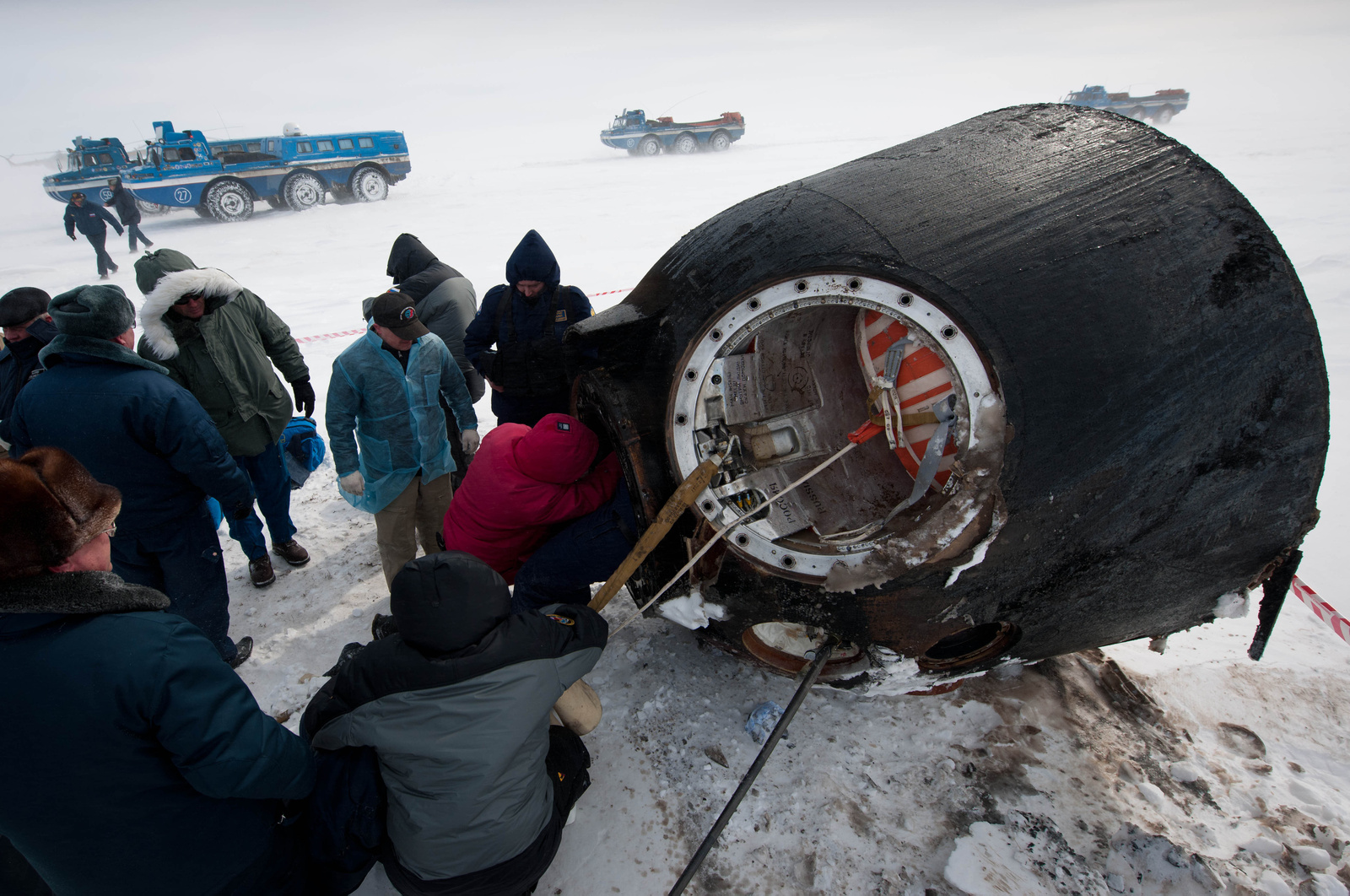Expedition 26 Lands Safely
By Source: NASA
Washington - Yest posadka! (We have Landing!) Welcome back home, Scott, Alex & Oleg! After 179 days in space (177 docked to ISS), Soyuz TMA-01M/24S, carrying Exp-26 crewmembers Alexander Kaleri, Oleg Skripochka (both Russia), and Scott Kelly (USA), landed successfully at 3:54am EDT this morning (local time: 1:54pm) in central Kazakhstan, 86 km north of the city of Arkalyk, under severe winter conditions. The descent capsule fell on its side, and the crew, which was in excellent condition, was quickly extracted by SAR (Search & Recovery) personnel. [TMA-01M (#701), the first fully “digital” Soyuz, undocked from the MRM2 (Mini Research Module 2) Poisk port early this morning at 12:26am EDT, after the crew had performed leak checks of the vestibule area between the MRM2 and the Soyuz spacecraft, of their Sokol suits and of the hatch between the Descent Module (SA) and Orbital Module (BO). Three minutes after physical undocking, Soyuz performed the first manual separation burn. This was followed at ~12:33am by the planned test of the new RODK Manual Attitude Control in Digital Mode which provides automated LVLH (Local Vertical-Local Horizontal) attitude control. After a second manual sep burn (~12:39am), Kaleri performed the planned test of the ROAK Manual Attitude Control in Analog Mode, which involved the three new orbit-installed rate sensors (“micro ammeters”), designed to provide the crew with information on roll rate & roll angle (officials later pronounced both tests successful). At about 2:56am, the crew activated the spacecraft’s VTsVK MCS (Motion Control System) “Chaika”. The actual de-orbit burn of 4 min 17 sec duration came at 3:03am, resulting in a 115.2 m/sec deceleration. Tri-module separation occurred at 3:28am. 16 sec after the separation command, software pitched the PAO (Instrumentation/Propulsion Module) in the rear to a specific angle (-78.5 deg from reference axis) which, if PAO would have remained connected to the SA/Descent Module, would have resulted in enough heating on the connecting truss to melt it, thus ensuring separation. Atmospheric entry followed at 3:31am and nominal parachute deployment at 3:40am. Following initial observation by Russian SAR personnel in two helicopters, the Soyuz vehicle landed in snow at 3:54am, tipping over in the wind. Because of local weather conditions (snow, wind, deep cold), the medical tent was not pitched this time. The crew was whisked by ATV (All-Terrain Vehicle) to their helos and flown to Kustanai where Scott Kelly boarded the waiting NASA-992 Gulfstream-III airplane which today is bringing him back to Houston (with 2 refueling stops),- the 4th direct return for USOS crewmembers. Sasha Kaleri & Oleg Skripochka meanwhile were flown on the GCTC Tu-134 back to Chkalovsky airfield of the Gagarin Cosmonaut Training Center at Zvezdniy Gorodok (Star City). During their mission, the Exp-26 crewmembers worked on more than 150 microgravity experiments in human research; biology and biotechnology; physical and materials sciences; technology development; and Earth & space sciences. They also supported the arrival of a fleet of international space vehicles – the Japanese HTV2 (H-II Transfer Vehicle 2) “Kounotori” (white stork), Russia’s cargo ship Progress 41P, the European ATV2 (Automated Transfer Vehicle 2) “Johannes Kepler”, and the Space Shuttle Discover/ULF5 on its final mission, delivering more than 11 tons of supplies necessary for working and living aboard the station. Kaleri has logged over 770 total days in space, Scott Kelly over 180 days, Skripochka 159 days (his first mission).]
Remaining on board for Increment 27 are CDR Dmitri “Dima” Kondratyev (Russia), FE-5 Paolo Nespoli (Italy) & FE-6 Cady Coleman (USA). They are having a free day today, getting back on regular wake/sleep cycle tomorrow (Thursday, 3/17). A new “troika” of Exp-27 flight engineers, Andrej Borisenko, Alexander Samokutyaev (both Russia) & Ron Garan (USA), will launch from the Baikonur Cosmodrome on the non-digital Soyuz
| Gyártó: |
Nikon D3X
|
| Fókusztáv: |
14mm
|
| Rekesz: |
f/6.3 |
| Zársebesség: |
1/1000
|
| ISO: |
100 |
| Készült: |
2011. márc. 16. 14:19
|


















































